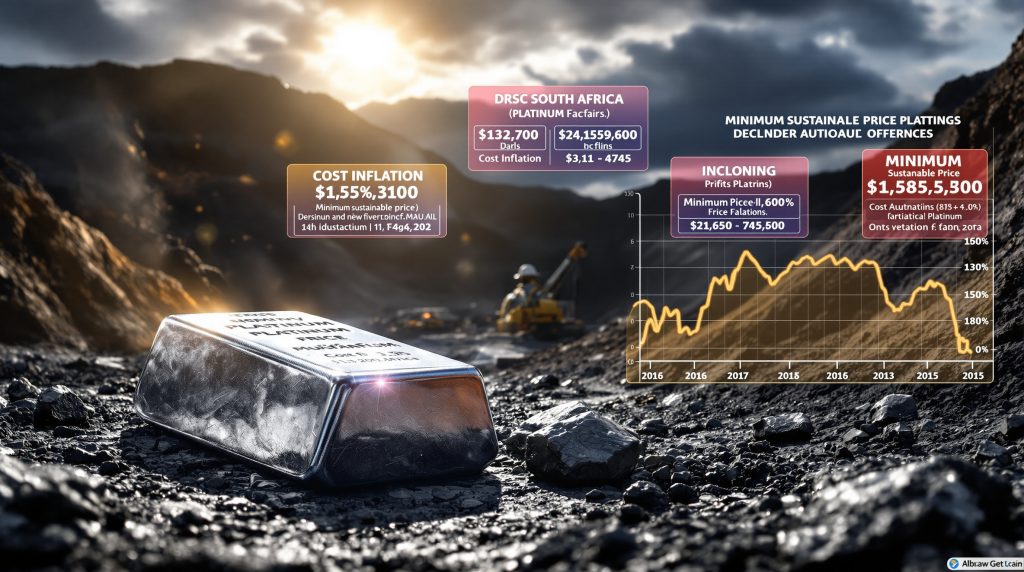How Serious Are Platinum Miners’ Financial Challenges in 2025?
The platinum mining sector faces significant profitability hurdles despite recent price improvements. With a 36% price rally in Q2 2025, many expected financial recovery, but underlying structural issues continue to threaten sustainability across the industry. Major producers report profit drops ranging from 14% to as high as 88%, highlighting the disconnect between price improvements and financial health. The number of operational mines in South Africa has declined dramatically, from 81 shafts in 2008 to only 53 in 2025, demonstrating the sector’s ongoing contraction.
Current platinum prices, despite recent improvements, remain below the threshold needed for sustainable operations. Industry analysts estimate that prices need to stabilize at substantially higher levels to justify new mine development and ensure long-term viability. This pricing challenge occurs against a backdrop of increasing production costs and shifting energy transition dynamics.
Current State of Platinum Mining Economics
The financial landscape for platinum miners remains challenging even with the recent price rally. Northam Platinum, a bellwether for the industry, reported a 14.4% drop in annual profit for the year ended June 2025, despite achieving record sales volumes. Headline earnings per share fell from 4.45 rand to 3.81 rand ($0.2169), illustrating how cost pressures can erode profit margins even when production volumes increase.
South African miners, who account for more than 70% of global platinum supply, find themselves in a particularly difficult position. The country’s South African beneficiation outlook has experienced sustained contraction, with the number of operational PGM (Platinum Group Metals) shafts falling by 35% since 2008. Industry experts project this decline to continue as marginal operations become economically unviable.
The production sustainability threshold remains a critical concern. According to industry analyses, current prices hover below the levels needed to support comprehensive reinvestment in existing operations, let alone the development of new projects. This creates a looming supply constraint that could eventually lead to more significant market imbalances.
What’s Driving the Platinum Price Recovery?
The recent platinum price rally stems from two primary factors creating a temporary market imbalance. After a prolonged period of depressed prices since early 2023, platinum experienced a remarkable 36% price increase during Q2 2025. This recovery, while welcome, appears driven by short-term factors rather than fundamental shifts in the market’s supply-demand balance.
Key Price Rally Catalysts
Chinese Import Surge
China has significantly increased its platinum imports in recent months, creating substantial buying pressure in the market. This activity appears to combine several factors:
- Strategic stockpiling by both state and private entities anticipating future supply constraints
- Recovery in specific industrial sectors that utilize platinum in manufacturing processes
- Potential speculative positioning based on expectations of future price increases
The Chinese buying activity represents a significant shift from previous years when imports remained relatively stable. Market analysts note that this pattern resembles historical cycles where Chinese buyers have strategically accumulated resources during price downturns.
South African Supply Constraints
Simultaneously, supply constraints from South Africa have supported higher prices:
- Production cuts at marginal operations that cannot sustain activity at lower price points
- Under-capitalization of remaining mines limiting output capacity
- Aging infrastructure affecting production reliability and increasing downtime
Many South African platinum mines operate with short remaining lifespans and insufficient capital investment, creating a natural decline in production volumes. Industry data shows that the number of operational PGM shafts has fallen by 28 since 2008, with expectations of further closures in coming years.
Market Sentiment Analysis
Despite the price improvement, industry leaders remain cautious about the sustainability of the rally. Northam Platinum CEO Paul Dunne emphasized that current prices are “still not yet at levels that will support sustainable mining across the industry and certainly not the much-needed development of new operations.”
This sentiment was echoed by Impala Platinum CEO Nico Muller, who warned against “flooding the market with new ounces,” indicating that major producers remain concerned about the market’s fundamental balance despite the recent price improvements.
Why Are Platinum Miners Still Struggling Despite Higher Prices?
The disconnect between rising platinum prices and continued financial struggles among miners stems from several fundamental challenges that higher metal prices alone cannot overcome. These structural issues create a persistent profitability gap that threatens the long-term sustainability of many operations.
Production Cost Inflation
Platinum miners face relentless cost pressures that erode profit margins despite price improvements:
| Cost Factor | Impact on Operations | Industry Average Increase (YoY) |
|---|---|---|
| Labor | Higher wage demands, productivity challenges | 8-12% |
| Energy | Power supply reliability issues, rising tariffs | 15-20% |
| Equipment | Import costs, maintenance expenses | 10-14% |
| Regulatory | Compliance requirements, permitting delays | 5-8% |
Labor costs represent one of the most significant expenses for platinum miners, particularly in South Africa where many operations rely heavily on labor-intensive mining methods. Wage negotiations consistently result in above-inflation increases, while productivity improvements lag behind. The South African mining industry has faced persistent labor relations challenges, with strikes and work stoppages adding to operational disruptions.
Energy costs have surged dramatically, with electricity tariffs in South Africa increasing at rates far exceeding general inflation. Power supply reliability issues force many operations to invest in backup generation capacity, further driving up operational expenses. The national power utility’s financial and operational challenges directly impact mining economics through both higher costs and production disruptions.
Equipment and maintenance expenses have increased substantially due to global supply chain pressures, import costs, and the specialized nature of mining equipment. Many operations run aging infrastructure that requires more frequent maintenance interventions, driving up per-ounce production costs.
Regulatory compliance requirements continue to evolve, adding layers of cost and complexity to operations. Environmental regulations, safety standards, and community development obligations create necessary but financially significant burdens on mining companies.
Capital Investment Shortfalls
The industry faces a critical under-investment cycle that threatens future production capacity:
Aging Infrastructure
Many South African mines operate with infrastructure developed decades ago that now requires substantial reinvestment. Key challenges include:
- Declining shaft infrastructure requiring expensive rehabilitation
- Processing plants operating beyond designed lifespans
- Water management systems needing modernization to meet environmental standards
- Limited remaining mine life making capital investments difficult to justify
The under-capitalization problem creates a vicious cycle: insufficient investment leads to operational inefficiencies and higher maintenance costs, which further reduce available capital for reinvestment. This dynamic accelerates the decline of marginal operations and threatens even well-established mines.
Development Pipeline Gaps
The pipeline of new platinum mining projects remains extremely thin, with few significant developments advancing toward production:
- Existing development projects face extended timelines due to funding constraints
- Investor hesitancy toward new capital commitments in the face of uncertain demand
- Competing investment opportunities in other commodity sectors drawing capital away
- Technical challenges in accessing deeper and more complex ore bodies
The combination of these factors creates a significant barrier to replacing depleting reserves. Industry analysts estimate that current development activity represents less than 20% of what would be required to maintain production levels over the coming decade.
How Are Demand Dynamics Shifting for Platinum Group Metals?
The platinum sector faces a complex demand landscape characterized by structural shifts in traditional markets alongside emerging opportunities in new applications. Understanding these changing dynamics is crucial for evaluating the long-term viability of platinum mining investments.
Traditional Market Challenges
The platinum sector faces structural demand headwinds from its traditional market:
Automotive Sector Transition
Platinum’s primary historical use has been in catalytic converters for internal combustion engines, particularly diesel vehicles. This market now faces multiple challenges:
- Declining market share for diesel engines, especially in European markets
- Reduced platinum loadings in newer catalytic converter designs
- Electric vehicle adoption accelerating beyond previous forecasts
- Hybrid vehicles creating transitional demand but with uncertain long-term trajectory
The automotive sector’s evolution represents an existential challenge for platinum demand. While the transition away from internal combustion engines may proceed more gradually than some forecasts suggest, the direction is clear and creates a fundamental uncertainty for long-term platinum demand.
Regional Demand Variations
Market dynamics vary significantly across regions, creating complex demand patterns:
- European diesel market contraction following emissions scandals and regulatory changes
- Varying emissions standards implementation timelines across global markets
- China’s automotive policy focusing increasingly on new energy vehicles
- Substitution with palladium in certain applications based on relative pricing
These regional variations create shifting demand patterns that complicate production planning and investment decisions for mining companies. The concentration of platinum production in South Africa creates particular vulnerability to these demand shifts.
Emerging Opportunity Areas
While traditional markets face challenges, new applications are developing:
Data Storage Applications
A notable bright spot in platinum group metals demand comes from unexpected sources:
- Growing demand for ruthenium (a platinum group metal) in data storage technologies
- Expansion of data centers globally driving specialized component needs
- Technological advancements requiring PGM materials for performance characteristics
- Limited substitution possibilities due to specific physical and chemical properties
Northam Platinum’s CEO specifically highlighted data storage applications as a source of new demand for ruthenium. This represents a potential diversification opportunity for producers who can optimize their processing to recover these minor PGMs efficiently.
Green Hydrogen Economy
Hydrogen technologies represent a significant potential growth area for platinum demand:
- Platinum catalysts play a critical role in proton exchange membrane electrolyzers
- Fuel cell technology advancement creating new applications for platinum
- Industrial decarbonization initiatives potentially driving substantial long-term demand
- Government policies increasingly supporting hydrogen economy development
While still in early development stages, the hydrogen economy could eventually create platinum demand at scales comparable to traditional automotive applications. However, the timeline for widespread adoption remains uncertain, creating a challenging transition period for mining companies.
What Strategies Are Platinum Miners Implementing to Survive?
Facing significant market pressures, platinum miners are implementing diverse strategies to maintain viability in a challenging environment. These approaches range from short-term operational interventions to fundamental business model transformations.
Operational Restructuring
Companies are implementing dramatic operational changes to weather the challenging market:
Production Rationalization
Platinum miners are strategically adjusting their production profiles to focus on higher-margin ounces:
- Closure of marginal shafts and operations that cannot achieve sustainable economics
- Concentration of production in higher-grade, lower-cost production areas
- Streamlining of processing operations to reduce fixed costs
- Deferral of development activities that cannot generate near-term returns
This production rationalization approach aims to preserve cash flow while maintaining optionality for future market improvements. However, it often involves difficult decisions regarding workforce reductions and community impacts.
Cost Containment Measures
Comprehensive cost reduction initiatives span all aspects of operations:
- Workforce optimization programs targeting improved labor productivity
- Energy efficiency initiatives to reduce exposure to rising electricity costs
- Supply chain restructuring to leverage economies of scale
- Maintenance strategy reviews to optimize equipment performance
These cost containment measures require careful implementation to avoid creating future operational risks. Short-term cost cutting that compromises infrastructure integrity or development activities can create more significant long-term challenges.
Strategic Repositioning
Forward-thinking producers are adapting their business models:
Portfolio Diversification
Mining companies are strategically adjusting their production mix to capture higher-value opportunities:
- Expanding into other PGMs with stronger demand profiles, particularly palladium and rhodium
- Developing by-product revenue streams from base metals like nickel and copper
- Geographic diversification where feasible to reduce concentration in South Africa
- Exploring recycling opportunities to capture value from secondary supply sources
This diversification approach helps mitigate exposure to platinum-specific market challenges while leveraging existing technical capabilities and infrastructure.
Vertical Integration Opportunities
Some producers are expanding their activities beyond mining into downstream segments:
- Moving downstream into refining and processing to capture additional margins
- Developing direct relationships with end-users to reduce intermediary costs
- Creating strategic partnerships with technology developers in emerging application areas
- Investing in recycling capabilities to secure material access
Vertical integration strategies can create competitive advantages but require significant capital investment and new capabilities development. Only the strongest companies can typically execute these strategies successfully.
What’s the Outlook for South Africa’s Platinum Industry?
South Africa’s platinum sector stands at a critical juncture, with transformative changes reshaping the industry landscape. As the dominant global producer accounting for over 70% of platinum supply, developments in the South African mining sector have far-reaching implications for the global market.
Production Landscape Evolution
South Africa’s platinum sector is undergoing significant transformation:
Consolidation Acceleration
Industry mining consolidation trends are accelerating as companies seek scale and operational synergies:
- Merger and acquisition activity increasing among mid-tier producers
- Asset sales from major companies to specialized operators
- Strategic partnerships to share infrastructure costs and technical capabilities
- Joint ventures to develop specific projects while spreading risk
This consolidation trend reflects the economic reality that many operations can no longer sustain independent existence. Scale benefits become increasingly important in managing fixed costs and negotiating with suppliers, labor, and customers.
Production Profile Shifts
The nature of platinum production in South Africa is evolving substantially:
- Declining overall output projected as marginal operations close
- Transition from deep conventional mining to mechanized operations where geology permits
- Focus on higher-grade assets with lower operating costs
- Increasing recovery of minor PGMs to improve overall economics
These production profile shifts represent both adaptation to market realities and technological evolution. The labor-intensive mining model that characterized South African platinum production for decades appears increasingly unsustainable in the current cost environment.
Socioeconomic Implications
The industry’s challenges extend beyond corporate balance sheets:
Employment Impacts
Workforce reductions create significant social challenges:
- Job losses from mine closures and restructuring affecting thousands of workers
- Community economic dependence on mining activities creating concentrated impacts
- Skills transition requirements for affected workers entering other sectors
- Intergenerational effects as mining employment pathways diminish
The employment impacts extend far beyond direct job losses, as each mining position typically supports multiple dependents and creates induced economic activity in surrounding communities.
Regional Development Consequences
Mining’s economic footprint extends throughout regional economies:
- Reduced fiscal contributions to government through taxes and royalties
- Infrastructure investment limitations affecting broader community development
- Community development program funding constraints as corporate social investment budgets shrink
- Supplier ecosystem contraction affecting small and medium enterprises
These regional development consequences create complex policy challenges for government authorities already facing fiscal constraints and social service delivery pressures.
Can Technology Innovation Help Platinum Miners Survive?
Technology innovation represents a potential pathway to improved economics for platinum miners, though implementation challenges remain significant. Strategic deployment of advanced technologies could address key cost drivers and operational inefficiencies that currently undermine profitability.
Operational Technology Advancements
Technological solutions offer potential pathways to improved economics:
Mechanization and Automation
Advances in mining equipment and control systems create opportunities for operational improvement:
- Remote operation capabilities reducing personnel exposure to hazardous environments
- Autonomous equipment deployment improving utilization and reducing variability
- Predictive maintenance systems minimizing unplanned downtime
- Semi-autonomous drilling and loading systems enhancing productivity
Implementing these technologies in existing operations presents significant challenges, particularly in older mines with constrained infrastructure. However, new developments and major expansions can incorporate these technologies from design, potentially achieving step-change improvements in operating economics.
Processing Efficiency Improvements
Metallurgical advances offer pathways to improved recovery and reduced processing costs:
- Recovery rate enhancements through advanced flotation technologies
- Energy consumption optimization in comminution circuits
- Water usage reduction technologies addressing both cost and environmental concerns
- Selective processing approaches for complex or lower-grade ores
These processing improvements can create meaningful economic benefits without requiring complete operational redesign, making them attractive for implementation at existing operations.
Digital Transformation Initiatives
Data-driven approaches are creating new optimization opportunities:
Advanced Analytics Applications
Leveraging operational data can identify efficiency opportunities previously invisible:
- Real-time production monitoring enabling rapid intervention for deviations
- Predictive modeling for operational planning and optimization
- Resource management optimization across complex value chains
- Energy usage optimization through intelligent load management
The implementation of AI-driven mining innovations requires both technological infrastructure and organizational capability development. Mining companies must develop new skills and working methods to capture the full value of these approaches.
Supply Chain Integration
Digital technologies enable more efficient management of complex supply networks:
- End-to-end visibility systems reducing inventory requirements
- Just-in-time inventory management minimizing working capital needs
- Supplier relationship optimization platforms enhancing procurement effectiveness
- Integrated planning systems reducing coordination costs
These supply chain innovations can significantly reduce working capital requirements and operational costs, particularly for larger operators with complex logistics networks.
When Will Platinum Mining Become Profitable Again?
Forecasting the return to sustainable profitability for platinum miners requires analyzing both supply-side adjustments and demand recovery factors. Industry analysts project a gradual rebalancing process rather than a sudden return to prosperity.
Market Rebalancing Timeline
Industry analysts project a gradual return to sustainable economics:
Supply-Side Adjustments
The ongoing rationalization of production capacity will eventually create more favorable market conditions:
- 2-3 years for production rationalization to complete across the industry
- Declining output from aging operations as reserves deplete
- Limited new supply coming online before 2028 due to development timelines
- Reduced operational flexibility reducing producers’ ability to respond to price signals
These supply-side adjustments will eventually create a tighter market balance, though the process involves significant pain for producers and their stakeholders. The limited development pipeline ensures that any demand recovery will encounter constrained supply capacity.
Demand Recovery Factors
Multiple factors could support demand stabilization or growth:
- Potential industrial application growth, particularly in emerging technologies
- Jewelry market stabilization after years of declining importance
- Investment demand fluctuations based on macroeconomic conditions
- Potential substitution back to platinum from palladium in some applications
The interaction between these supply and demand factors creates significant forecast uncertainty. However, most industry analysts project a gradual improvement in market balance beginning in late 2026 or 2027, potentially supporting more sustainable price levels.
Price Threshold Requirements
For sustainable operations, the industry needs:
Minimum Sustainable Price Levels
Different operational profiles require varying price support:
- $1,500-1,700/oz for existing operations with established infrastructure
- $1,800-2,000/oz for new project development and major expansions
- Sustained pricing above these thresholds for 12+ months to restore investor confidence
These price thresholds vary significantly based on individual mine characteristics, with factors such as grade, mining method, depth, and infrastructure all influencing the economic viability at different price points.
The current pricing environment, while improved from recent lows, remains insufficient to support comprehensive reinvestment across the industry. Without sustained higher prices, the sector’s production capacity will continue to erode through attrition of aging operations.
What Should Investors Watch in the Platinum Mining Sector?
Investors considering the platinum mining sector should monitor several critical indicators to identify potential investment opportunities and risks. The industry’s complex dynamics require nuanced analysis beyond simple price tracking.
Key Performance Indicators
Investors should monitor several critical metrics:
Cost Position Trends
Understanding cost structures provides insight into operational sustainability:
- All-in sustaining cost (AISC) trajectories relative to current and projected prices
- Cost-cutting initiative effectiveness and sustainability
- Operational efficiency improvements that create structural cost advantages
- Energy intensity metrics given the significance of power costs
Companies that can demonstrate sustainable cost improvements rather than short-term measures will likely outperform over time. Investors should scrutinize the nature of cost reductions to assess their long-term viability.
Balance Sheet Strength
Financial resilience determines a company’s ability to weather continued market challenges:
- Debt levels and refinancing requirements in coming years
- Liquidity positions relative to operational and capital requirements
- Capital allocation priorities between maintenance, growth, and shareholder returns
- Covenant headroom providing financial flexibility
Balance sheet strength has become increasingly important given the extended period of market challenges. Companies with lower leverage and stronger liquidity positions can withstand further market volatility and potentially capitalize on distressed asset opportunities.
Strategic Positioning Factors
Company-specific approaches will determine winners and losers:
Asset Quality Differentiation
Not all platinum operations are created equal:
- Reserve grade and mine life profiles indicating long-term production potential
- Operational flexibility to adjust production profiles as market conditions change
- By-product credit potential from other PGMs and base metals
- Infrastructure quality and replacement requirements
High-quality assets provide a foundation for sustainable operations even in challenging market conditions. Investors should carefully assess the underlying asset quality beyond current production metrics.
Management Execution Capability
Leadership effectiveness becomes particularly critical in challenging markets:
- Restructuring implementation effectiveness and communication transparency
- Innovation adoption rates across operational and business processes
- Stakeholder relationship management, particularly with labor and communities
- Strategic vision clarity and consistency of implementation
Companies with leadership teams demonstrating adaptability and operational excellence tend to outperform regardless of market conditions. Investors should assess management track records and capability to navigate complex operating environments.
FAQ: Platinum Mining Industry Challenges
Why are platinum miners struggling when prices have increased by 36%?
The recent price rally, while positive, hasn’t offset the accumulated impact of years of underinvestment, rising costs, and structural demand changes. The 36% increase in Q2 2025 represents a significant improvement but comes after an extended period of depressed prices that eroded operational capabilities and financial resources. Many operations remain unprofitable at current price levels due to persistent cost inflation across labor, energy, and equipment categories. Additionally, the industry needs sustained higher prices to restore financial health and support new development after years of capital expenditure deferrals.
How many platinum mines have closed in South Africa since 2008?
The number of operational PGM shafts in South Africa has declined dramatically from 81 in 2008 to just 53 in 2025, representing a 35% reduction in active mining operations. This trend reflects both the consolidation of operations and the outright closure of economically unviable assets. Industry projections indicate this contraction will continue as aging operations reach the end of their economic lives and insufficient capital is available for replacement capacity development.
What price level do platinum miners need to become profitable again?
Industry experts suggest prices need to consistently remain above $1,500-1,700 per ounce for existing operations to be sustainable, while new project development requires $1,800-2,000 per ounce to attract investment capital. These thresholds vary based on individual mine characteristics such as grade, depth, mining method, and infrastructure requirements. Current prices remain below these thresholds for many producers, particularly those operating higher-cost, labor-intensive operations. Sustained pricing above these levels for at least 12 months would likely be required to restore investor confidence.
How is the electric vehicle transition affecting platinum demand?
The shift toward electric vehicles reduces demand for platinum in traditional catalytic converters, creating a structural headwind for platinum demand. Internal combustion engines, particularly diesel engines that typically use platinum-based catalysts, face declining market share as automotive manufacturers increase electric vehicle production. This transition is occurring at different rates across global markets but represents a long-term challenge for platinum demand. However, platinum’s role in hydrogen fuel cells and other green technologies may partially offset this decline in the longer term as these technologies mature and achieve commercial scale.
Are any new platinum mines being developed globally?
Very few new platinum mining projects are advancing to construction due to economic challenges. Most capital investment is focused on maintaining existing operations rather than developing new mines, creating potential supply constraints in the coming years. The development pipeline remains extremely thin, with only a handful of significant projects advancing toward production decisions. Most of these projects require substantially higher platinum prices to achieve acceptable investment returns. This limited development activity suggests that any demand recovery will encounter significant supply constraints, potentially supporting higher prices in the medium term.
Further Exploration:
Readers interested in learning more about the platinum mining industry can explore related educational content from Mining.com, which offers regular updates on developments in the platinum sector and broader mining industry evolution. The platinum market’s complexity and ongoing evolution make it a fascinating case study in commodity market dynamics and mining economics.
Wondering How to Spot the Next Major Mining Discovery?
Discovery Alert’s proprietary Discovery IQ model provides real-time notifications when significant mineral discoveries are announced on the ASX, giving investors a crucial market advantage. Explore historic examples of exceptional returns from major discoveries on our dedicated discoveries page and position yourself ahead of the market.




